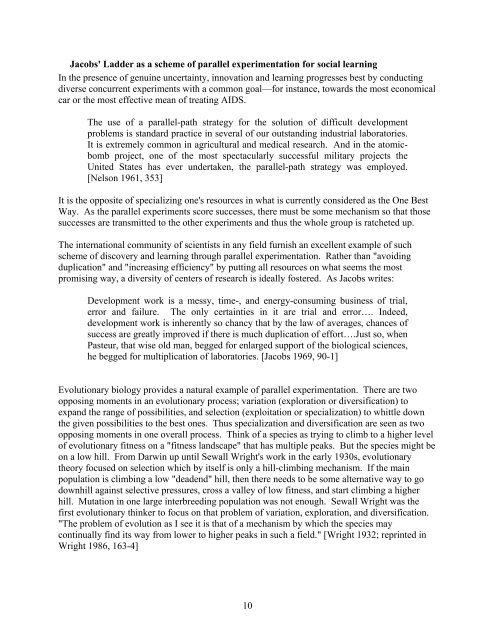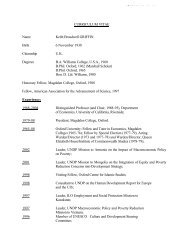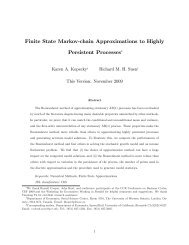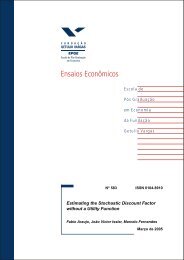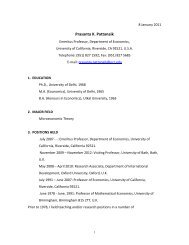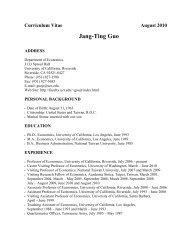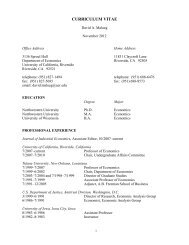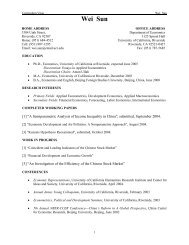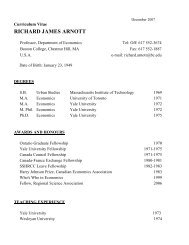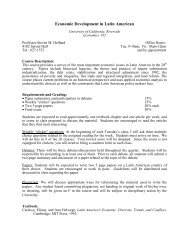Jane Jacobs on Diversification and Specialization - Economics
Jane Jacobs on Diversification and Specialization - Economics
Jane Jacobs on Diversification and Specialization - Economics
You also want an ePaper? Increase the reach of your titles
YUMPU automatically turns print PDFs into web optimized ePapers that Google loves.
<str<strong>on</strong>g>Jacobs</str<strong>on</strong>g>' Ladder as a scheme of parallel experimentati<strong>on</strong> for social learning<br />
In the presence of genuine uncertainty, innovati<strong>on</strong> <strong>and</strong> learning progresses best by c<strong>on</strong>ducting<br />
diverse c<strong>on</strong>current experiments with a comm<strong>on</strong> goal—for instance, towards the most ec<strong>on</strong>omical<br />
car or the most effective mean of treating AIDS.<br />
The use of a parallel-path strategy for the soluti<strong>on</strong> of difficult development<br />
problems is st<strong>and</strong>ard practice in several of our outst<strong>and</strong>ing industrial laboratories.<br />
It is extremely comm<strong>on</strong> in agricultural <strong>and</strong> medical research. And in the atomicbomb<br />
project, <strong>on</strong>e of the most spectacularly successful military projects the<br />
United States has ever undertaken, the parallel-path strategy was employed.<br />
[Nels<strong>on</strong> 1961, 353]<br />
It is the opposite of specializing <strong>on</strong>e's resources in what is currently c<strong>on</strong>sidered as the One Best<br />
Way. As the parallel experiments score successes, there must be some mechanism so that those<br />
successes are transmitted to the other experiments <strong>and</strong> thus the whole group is ratcheted up.<br />
The internati<strong>on</strong>al community of scientists in any field furnish an excellent example of such<br />
scheme of discovery <strong>and</strong> learning through parallel experimentati<strong>on</strong>. Rather than "avoiding<br />
duplicati<strong>on</strong>" <strong>and</strong> "increasing efficiency" by putting all resources <strong>on</strong> what seems the most<br />
promising way, a diversity of centers of research is ideally fostered. As <str<strong>on</strong>g>Jacobs</str<strong>on</strong>g> writes:<br />
Development work is a messy, time-, <strong>and</strong> energy-c<strong>on</strong>suming business of trial,<br />
error <strong>and</strong> failure. The <strong>on</strong>ly certainties in it are trial <strong>and</strong> error…. Indeed,<br />
development work is inherently so chancy that by the law of averages, chances of<br />
success are greatly improved if there is much duplicati<strong>on</strong> of effort….Just so, when<br />
Pasteur, that wise old man, begged for enlarged support of the biological sciences,<br />
he begged for multiplicati<strong>on</strong> of laboratories. [<str<strong>on</strong>g>Jacobs</str<strong>on</strong>g> 1969, 90-1]<br />
Evoluti<strong>on</strong>ary biology provides a natural example of parallel experimentati<strong>on</strong>. There are two<br />
opposing moments in an evoluti<strong>on</strong>ary process; variati<strong>on</strong> (explorati<strong>on</strong> or diversificati<strong>on</strong>) to<br />
exp<strong>and</strong> the range of possibilities, <strong>and</strong> selecti<strong>on</strong> (exploitati<strong>on</strong> or specializati<strong>on</strong>) to whittle down<br />
the given possibilities to the best <strong>on</strong>es. Thus specializati<strong>on</strong> <strong>and</strong> diversificati<strong>on</strong> are seen as two<br />
opposing moments in <strong>on</strong>e overall process. Think of a species as trying to climb to a higher level<br />
of evoluti<strong>on</strong>ary fitness <strong>on</strong> a "fitness l<strong>and</strong>scape" that has multiple peaks. But the species might be<br />
<strong>on</strong> a low hill. From Darwin up until Sewall Wright's work in the early 1930s, evoluti<strong>on</strong>ary<br />
theory focused <strong>on</strong> selecti<strong>on</strong> which by itself is <strong>on</strong>ly a hill-climbing mechanism. If the main<br />
populati<strong>on</strong> is climbing a low "deadend" hill, then there needs to be some alternative way to go<br />
downhill against selective pressures, cross a valley of low fitness, <strong>and</strong> start climbing a higher<br />
hill. Mutati<strong>on</strong> in <strong>on</strong>e large interbreeding populati<strong>on</strong> was not enough. Sewall Wright was the<br />
first evoluti<strong>on</strong>ary thinker to focus <strong>on</strong> that problem of variati<strong>on</strong>, explorati<strong>on</strong>, <strong>and</strong> diversificati<strong>on</strong>.<br />
"The problem of evoluti<strong>on</strong> as I see it is that of a mechanism by which the species may<br />
c<strong>on</strong>tinually find its way from lower to higher peaks in such a field." [Wright 1932; reprinted in<br />
Wright 1986, 163-4]<br />
10


